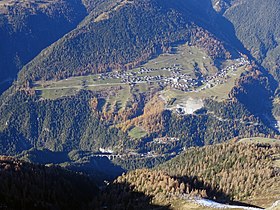Davos meadows
| Davos meadows | ||
|---|---|---|
| State : |
|
|
| Canton : |
|
|
| Region : | Prättigau / Davos | |
| Political community : | Davos | |
| Postal code : | 7494 | |
| former BFS no. : | 3523 | |
| Coordinates : | 774 088 / 175135 | |
| Height : | 1421 m above sea level M. | |
| Area : | 29.58 km² | |
| Residents: | 364 (December 31, 2007) | |
| Population density : | 12 inhabitants per km² | |
| Website: | www.wiesen.ch | |
|
Wiesen, below the Wiesen Viaduct , taken from the Muchetta . |
||
| map | ||
|
|
||
Davos Wiesen (in Walser local dialect an de Wise [andə ˈʋɪʓə] , Rhaeto-Romanic ) is a village (until the end of 2018 a parliamentary community ) in the municipality of Davos in the Prättigau-Davos district of the Swiss canton of Graubünden .
coat of arms
Description: In gold (yellow) two blue wolf fishing rods facing each other . The model was the coat of arms of the Beeli von Belfort , which is shown in the colors of the Ten Court Association .
population
languages
Despite the Romanesque neighborhood, German has been spoken in Davos Wiesen since the Middle Ages, as the residents of Davos are immigrant Walsers . The language situation in the last few decades is shown in the table below:
| Languages in Davos Wiesen | ||||||
| languages | 1980 census | 1990 census | 2000 census | |||
| number | proportion of | number | proportion of | number | proportion of | |
| German | 213 | 94.67% | 290 | 96.03% | 292 | 97.01% |
| Graubünden Romance | 7th | 3.11% | 5 | 1.66% | 5 | 1.66% |
| Italian | 1 | 0.44% | 1 | 0.33% | 0 | 0.00% |
| Residents | 225 | 100% | 302 | 100% | 301 | 100% |
Origin and nationality
Of the 347 residents at the end of 2005, 276 (= 79.54%) were Swiss citizens.
history
In the 13th century, Walsers settled in this area, which was only sporadically populated by Romans . Today the Wiesner Alp , which they founded, is considered one of the most important Alps in the canton. Gradually a terrace village developed. Today there are 340 inhabitants and several settlement areas, for example the late Gothic Reformed Church (1430 m) with wall paintings in the nave and a well-preserved Rococo organ from 1774, the upper village and the RhB train station at 1200 m above sea level. M.
In the 16th century the community joined the Reformation . Tensions with the still Catholic neighboring communities Schmitten or Alvaneu persisted for a long time. From 1613 to 1851 Wiesen was one of the three neighborhoods of the Inner-Belfort half-court, which formed its own lower court with free choice of Ammann. From 1851 Wiesen belonged to the then newly formed Bergün district .
In 1909 the place was opened up with the railway line Davos-Filisur of the Rhaetian Railway, which made the construction of the Wiesener Viaduct necessary. The German painter Ernst Ludwig Kirchner lived temporarily in Davos and painted some motifs from the community of Wiesen, including his last major work, Die Brücke bei Wiesen , which he completed in 1926.
On January 1, 2009, the municipality of Wiesen merged with the municipality of Davos after the merger had been approved in a referendum in both municipalities. The merger also resulted in the transfer to the Davos district , which is congruent with the Davos community and existed until the end of 2015.
Ernst Ludwig Kirchner: The Bridge at Wiesen (1926)
Attractions
literature
- Erwin Poeschel : The art monuments of the canton of Graubünden II. The valley communities Herrschaft, Prättigau, Davos, Schanfigg, Churwalden, Albula valley. (= Art Monuments of Switzerland. Volume 9). Edited by the Society for Swiss Art History GSK. Bern 1937. DNB 811066703 .
- Jürg Simonett: Wiesen (GR). In: Historical Lexicon of Switzerland .
Web links
Individual evidence






